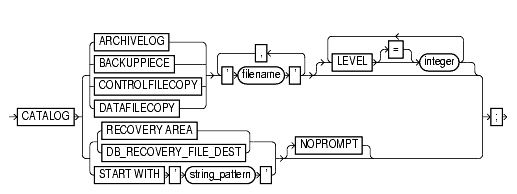| Oracle® Database Recovery Manager Reference 10g Release 1 (10.1) Part Number B10770-02 |
|
|
View PDF |
| Oracle® Database Recovery Manager Reference 10g Release 1 (10.1) Part Number B10770-02 |
|
|
View PDF |
catalog::=

Use the CATALOG command to do the following:
| See Also:
Oracle Database Backup and Recovery Basics to learn how to manage target database records stored in the catalog |
RMAN treats all user-managed backups as image copies. Note that during cataloging, RMAN does not check whether the file was correctly copied by the operating system utility: it just checks the header.
CATALOG to catalog a file that belongs to a different database.CATALOG to catalog a backup piece that exists on an sbt device.This example assumes that you made operating system copies of archived logs or transferred them from another location, and then added them to the RMAN repository:
CATALOG ARCHIVELOG '?/oradata/archive1_30.dbf', '?/oradata/archive1_31.dbf', '?/oradata/archive1_32.dbf';
The following example catalogs datafile copy users01.bak as an incremental level 0 backup:
CATALOG DATAFILECOPY '?/oradata/users01.bak' LEVEL 0;
Note that you can create datafile copies both with the RMAN BACKUP AS COPY command and by using operating system utilities in conjunction with ALTER TABLESPACE BEGIN/END BACKUP.
The following example catalogs a directory full of archived logs that were copied into the /tmp/arch_logs directory with an operating system utility:
CATALOG START WITH '/tmp/arch_logs';
The following example catalogs all files in the currently enabled flash recovery area without prompting the user for each one:
CATALOG RECOVERY AREA NOPROMPT;
The following example catalogs a backup piece that was copied with an operating system utility:
CATALOG BACKUPPIECE '?/oradata/01dmsbj4_1_1.bcp';